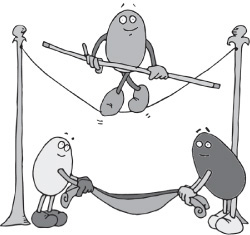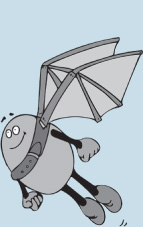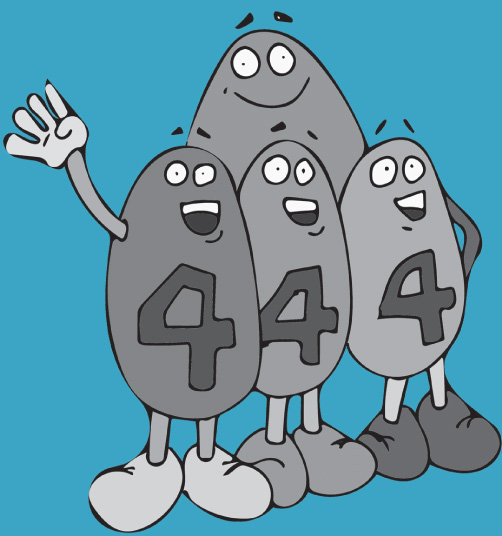At Level Four, people feel free to voice their ideas. Not just their safest and best ideas, but also their brand-new ideas, whether half or fully baked...
Because their colleagues and leaders listen to them.
And support them.
And build on their ideas to create better ideas together that none could have imagined individually.
And all share in the credit. But more importantly, all share in the joy of creation and collaboration and being part of something greater than themselves.

We don’t have to work together for years before giving each other the benefit of the doubt.
We start with an implicit assumption of trust.
At Level Four, interaction safety is foundational.
In a Level Four organization, every interaction begins with an implicit assumption that all parties of the interaction are allies who look for ways to support one another and are committed to working together for their mutual success and the success of the organization.
There is a fundamental difference between this kind of interaction and the kinds of interactions that happen at Levels One and Two (and, in many places, at Level Three). Teams in Level Four organizations start as high-performing, collaborative partnerships instead of being characterized by guarded, testing, and often combative interactions.
Leaders throughout the organization no longer see interaction safety as “soft stuff” that is disconnected from the work of the organization. In fact, they see that more ideas are shared, which leads to retention of talent, greater speed to market, efficiencies in process, and improvements in quality.
As people feel safer to speak up, fewer mistakes are made. Problems are made visible and solved quickly. Meetings are productive spaces for sharing information, getting a 360-degree view of a problem, and making decisions. Time and energy are saved instead of wasted.
People start their workdays feeling energized and valued, expecting to contribute, ready to collaborate, open to new ideas, willing to share their thoughts, and excited to be part of the collective enterprise. They bring their full selves to work. At the end of their workdays, people might be physically tired, but they leave fulfilled and look forward to the next day’s challenges and collaborations.

We walk into meetings ready to collaborate, knowing our colleagues have our backs.
Supported by the liberating, empowering sense of interaction safety, people share information freely and easily without barriers. They engage with each other in authentic interactions. They are willing to lean into discomfort and address conflicts and disagreements as gateways to creativity and inclusion.
People feel free to exchange ideas without fear of feeling judged. Interactions start with the assumption that those involved have trust. People work hard to maintain that trust by investing in one another.
Disrespectful actions and judgmental behaviors are seen as outside organizational norms and quickly challenged and stopped. Judging or unfairly challenging behaviors are recognized and pointed out with care and respect.

I am concerned not only with my interaction safety but also with yours.
People understand that everyone does not feel safe in every interaction, every day. People make it a point to ask their colleagues what they need to feel safe. They work together to create that environment.

Bridget is the best kind of ambassador for her company. Bridget’s good friend Jamal asks her why she is so excited about her organization. “I love my work, my colleagues, and the environment. I feel respected, and I am doing great work. I never feel like I need to censor myself. When I share an idea, others build on it. Together, we are achieving great results and surpassing our competition. I feel creative and challenged every day.
“When new people join, we want to learn from them. We want to hear about areas for improvement that they are seeing with their fresh eyes.
“We have a really strong foundation of trust, and we assume others will bring value. We seek out others: Who is missing? Who needs to be included? What differences in perspective do we need to solve this problem?
“We have created an amazing environment in which we are all growing, learning, and doing better together than we would alone. And we know we need to keep working at it.”
![]() Human resources policies, practices, and management systems enhance and maintain a culture of interaction safety.
Human resources policies, practices, and management systems enhance and maintain a culture of interaction safety.
![]() Organizational values support a culture of interaction safety—candidness, trust, and transparency.
Organizational values support a culture of interaction safety—candidness, trust, and transparency.
![]() People support one another’s growth, build on one another’s ideas, and enjoy doing their best work together.
People support one another’s growth, build on one another’s ideas, and enjoy doing their best work together.
![]() The culture is fun and exciting.
The culture is fun and exciting.
![]() Honest, authentic interactions are the norm.
Honest, authentic interactions are the norm.
![]() The environment encourages the search for diverse perspectives and information, leading to faster decision-making and problem solving. People are eager to have dialogue across differences and are skilled in doing so.
The environment encourages the search for diverse perspectives and information, leading to faster decision-making and problem solving. People are eager to have dialogue across differences and are skilled in doing so.
![]() When people are talking about organizational results, interaction safety is always a part of the discussion since it is so integrated into how results are achieved.
When people are talking about organizational results, interaction safety is always a part of the discussion since it is so integrated into how results are achieved.
![]() New people are welcomed, listened to, and valued for their prior experiences and new perspectives.
New people are welcomed, listened to, and valued for their prior experiences and new perspectives.
![]() Leaders and team members are proactive in sustaining a culture of interaction safety.
Leaders and team members are proactive in sustaining a culture of interaction safety.
![]() Checklists and check-ins for interaction safety are integrated into all practices, processes, and meetings. People feel safe interacting with others but don’t take interaction safety for granted.
Checklists and check-ins for interaction safety are integrated into all practices, processes, and meetings. People feel safe interacting with others but don’t take interaction safety for granted.

We expect the best of each other, and we support each other so each of us can be our best self, doing our best work together, and grow to become even better.

By empowering others, Kristen finds she is reenergizing herself. Kristen is leading a meeting of her team and talking about a new initiative she created that she’s excited about when one member raises his hand and questions an underlying assumption. Another member agrees and suggests a significant change to Kristen’s plan. She reacts well. Kristen checks her immediate impulse to reject the assertion, stops, listens to their comments, asks for more, sees the wisdom of their additions, and adjusts the plan accordingly. The team members feel listened to and know they really added value. She recognizes that the end product is much stronger. And it all took minutes.
How We Interact in Meetings: Level Four
“Normal” behaviors, interactions, and responses
Written rules and road signs |
People know and live the behaviors that create interaction safety. |
When someone is talking |
People listen supportively and find ways to add value and useful ideas to most, if not all, conversations. |
Interactions with the meeting leader |
Everyone is there to contribute or would not have been invited. People speak freely. |
Interactions with other team members |
Interaction safety with others is assumed. |
When someone challenges an idea |
Actively engage others to hear their different points of view. |
Outcome of interactions |
Creativity, faster problem solving, and breakthroughs are common. |

New people are welcomed as untapped resources for fresh ideas and new perspectives.
They are encouraged to spread their wings and soar
. . . but sometimes shushed until they “learn the ropes.”
Thinking about his new job, Hassan is tempted to pinch himself. Hassan is truly excited to be at his new job and new company. He smiles to himself, remembering that he always wanted to work with this company. He admired its great mission and products and was attracted to what he heard about its culture of trust, inclusion, and collaboration.
Throughout the interview process, Hassan could feel people’s genuineness. The vibe was warm and sincere, and the interviewers showed interest in who he was as a person in addition to all he could bring to the company. He was impressed with the level of honesty and openness in his interactions with potential team members and also with the organization’s leaders. People shared information with him not only about the job but also about their backgrounds and their hopes for and concerns about the organization. They were real and forthcoming.
As Hassan thinks about his new position, he realizes he is a bit overwhelmed by the level of authority and empowerment he has, but he feels well supported by his new colleagues and leaders, who have made it clear they will help him navigate his learning curve. Best of all, he has already been able to contribute and his ideas have been welcomed.
Colleagues have said they want him to bring his perspectives to the table. What an exciting way to start! The future here looks bright.
Now it’s time for that lunch meeting with his colleagues, a mandatory part of on-boarding. Hassan knows that taking the time to build connections with others is a critical part of creating trust and interaction safety. He can’t wait to see what he and his new teammates are able to accomplish together.

People who don’t fit the traditional profile for employees in other organizations often feel very much at home, for the first time.
Jayden found an old folder with his resume in it, and he starts to think . . . He has been working at the organization for more than five years, longer than he’s worked anywhere else. Jayden is surprised he’s been here this long, and he reflects on why. This organization and its environment are so different from any other place he has been.
In the past, Jayden felt he was often treated differently from others because of his race. But in this organization, people value all he has to bring—not just his different perspectives and technical skills but also his potential.
Jayden is surrounded by diverse team members. His team is a mix of races, genders, national origins, sexual orientations, gender identities, religions, and styles. There is so much diversity that Jayden no longer feels as though he stands out as an individual, as he has in other organizations. Everyone stands out, and that is valued. Having that diversity has enabled the team to be innovative, opening up new markets, developing new products, and designing new services for customers. It’s a great place to work and engage with others.
“Why would I want to leave?” he thinks.
Soaring Higher

Here are some everyday actions to help you soar higher.
You can only achieve Level Four by working to achieve and sustain it every day.
Individual Actions: Taking Risks
![]() Don’t take interaction safety for granted. Check in with new and existing team members on what they need for interaction safety.
Don’t take interaction safety for granted. Check in with new and existing team members on what they need for interaction safety.
![]() Practice the 4 Keys for teamwork and collaboration: Listen as an Ally, Lean into Discomfort, State Your Intent and Intensity, and Share Your Street Corner.
Practice the 4 Keys for teamwork and collaboration: Listen as an Ally, Lean into Discomfort, State Your Intent and Intensity, and Share Your Street Corner.
![]() Address conflicts when they arise.
Address conflicts when they arise.
![]() Share your ideas and observations about needs and opportunities for enhancing interaction safety in the organization with team members and leaders.
Share your ideas and observations about needs and opportunities for enhancing interaction safety in the organization with team members and leaders.
![]() Keep raising the bar on interaction safety.
Keep raising the bar on interaction safety.
Leader and Organization Actions
![]() Model the behaviors and attitudes needed to create interaction safety.
Model the behaviors and attitudes needed to create interaction safety.
![]() Ensure new leaders are coached and developed to practice interaction safety behaviors.
Ensure new leaders are coached and developed to practice interaction safety behaviors.
![]() Review and conduct listening tours to ensure interaction safety continues to be a foundational part of the culture.
Review and conduct listening tours to ensure interaction safety continues to be a foundational part of the culture.
![]() Make sure creating interaction safety is a skill requirement that is included in performance reviews and compensation discussions for all organizational leaders.
Make sure creating interaction safety is a skill requirement that is included in performance reviews and compensation discussions for all organizational leaders.
![]() Continue to assess how the organization is doing in regard to interaction safety.
Continue to assess how the organization is doing in regard to interaction safety.
![]() Involve new hires early in their employment and involve social identity groups regarding how they are experiencing interaction safety and areas for improvement.
Involve new hires early in their employment and involve social identity groups regarding how they are experiencing interaction safety and areas for improvement.
![]() Recognize the need to refresh and reinvigorate the focus on interaction safety for continuous improvement.
Recognize the need to refresh and reinvigorate the focus on interaction safety for continuous improvement.
![]() Continue to share examples of how interaction safety is impacting individual, team, and organizational performance.
Continue to share examples of how interaction safety is impacting individual, team, and organizational performance.






